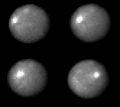Fexeiro:Ceres Rotation.jpg

Tamanho desta antebison: 676 × 600 píxeles. Outras resoluçones: 270 × 240 píxeles | 541 × 480 píxeles | 880 × 781 píxeles.
Fexeiro oureginal (880 × 781 píxeles, tamanho: 94 KB, tipo MIME: image/jpeg)
Stórico de l fexeiro
Clique an ua data/hora para ber l fexeiro tal cumo el staba naquel sfergante.
| Data i hora | Amostra | Tamanho | Outelizador | Comentairo | |
|---|---|---|---|---|---|
| atual | 07h53min de 30 de janeiro de 2006 |  | 880 × 781 (94 KB) | Arnomane | higher resolution |
| 13h17min de 9 de setembre de 2005 |  | 300 × 300 (4 KB) | Vesta~commonswiki | {{Information| |Description = NASA's Hubble Space Telescope took these images of the asteroid 1 Ceres over a 2-hour and 20-minute span, the time it takes the Texas-sized object to complete one quarter of a rotation. One day on Ceres lasts 9 hours. The bri |
Lhigaçones de l fexeiro
Esta páigina lhiga este fexeiro:
Outelizaçon global dun fexeiro
Las seguintes wikis outelizan este fexeiro:
- Outelizaçon na ba.wikipedia.org
- Outelizaçon na be-tarask.wikipedia.org
- Outelizaçon na bs.wikipedia.org
- Outelizaçon na ca.wikipedia.org
- Outelizaçon na ca.wikinews.org
- Outelizaçon na cs.wikipedia.org
- Outelizaçon na el.wikipedia.org
- Outelizaçon na eo.wikipedia.org
- Outelizaçon na es.wikinews.org
- Outelizaçon na fa.wikipedia.org
- Outelizaçon na fr.wikipedia.org
- Outelizaçon na hu.wikipedia.org
- Outelizaçon na hy.wikipedia.org
- Outelizaçon na id.wikipedia.org
- Outelizaçon na it.wikipedia.org
- Outelizaçon na ja.wikipedia.org
- Outelizaçon na ka.wikipedia.org
- Outelizaçon na ko.wikipedia.org
- Outelizaçon na mk.wikipedia.org
- Outelizaçon na nl.wikipedia.org
- Outelizaçon na no.wikipedia.org
- Outelizaçon na oc.wikipedia.org
- Outelizaçon na ru.wikipedia.org
- Outelizaçon na sk.wikipedia.org
- Outelizaçon na te.wikipedia.org
- Outelizaçon na tl.wikipedia.org
- Outelizaçon na zh.wikipedia.org
